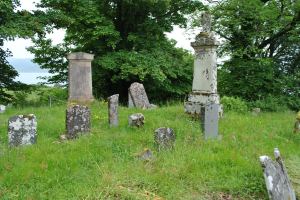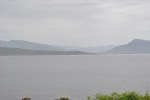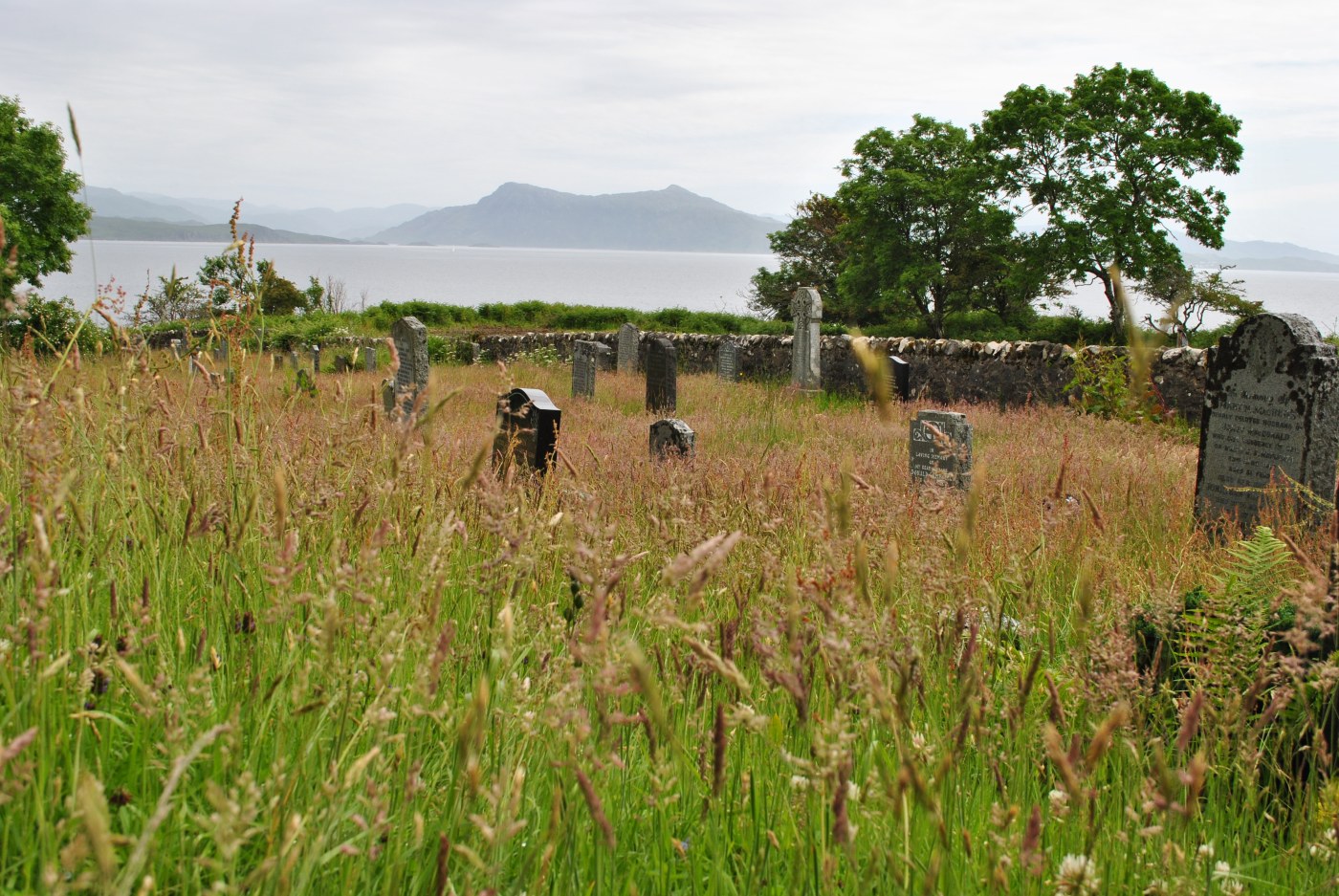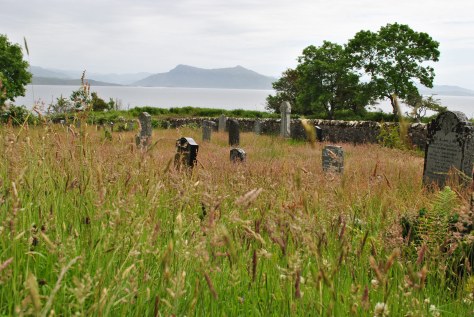The following lines were read in 1746 in Kilmore churchyard:
 If Heaven be pleased when sinners cease to sin,
If Heaven be pleased when sinners cease to sin,
If Hell be pleased when sinners enter in,
If Earth be pleased to quit a truckling knave,
Then all be pleased; Macdonald’s in his grave.
Otta F. Swire: Skye – The Island & its Legends, Birlinn; 1952, p. 200f
What a strange funeral this must have been!
sacred through the centuries
 St. Columba landed at Kilmore in the 6th century and blessed the ground already a sacred place since the druids. The old church that dates back to 1681 lies in ruin now, the graveyard still in the summer sun. This is the traditional burial place of the Macdonalds of Sleat, the early chiefs were buried on Iona, the graveyard of the kings.
St. Columba landed at Kilmore in the 6th century and blessed the ground already a sacred place since the druids. The old church that dates back to 1681 lies in ruin now, the graveyard still in the summer sun. This is the traditional burial place of the Macdonalds of Sleat, the early chiefs were buried on Iona, the graveyard of the kings.
the controversial chief
Alexander Macdonald was a chief loved and hated in the various degrees. Hence the epitaph!
His burial was the biggest that Kilmore on the Sleat peninsula on the Isle of Skye had seen. The 7th baronet was buried here in 1746, a year after the Jacobite rising he had refused to join. He had not seen a chance of succeeding and he owed the King. The House of Hanover had given the clan lands back to him, that had been lost after the first Jacobite rising in 1715.
battle of wits
 Not long before his death and rather memorable funeral, Alexander Macdonald met the Duke of Cumberland in Inverness.
Not long before his death and rather memorable funeral, Alexander Macdonald met the Duke of Cumberland in Inverness.
 The Duke allegedly cracked this line on seeing him:
The Duke allegedly cracked this line on seeing him:
“Is this the great rebel of the Isles?
The chief replied with pride and esprit:
 “My Duke, Had I been the rebel of the Isles Your Royal Highness had never crossed the Spey.”
“My Duke, Had I been the rebel of the Isles Your Royal Highness had never crossed the Spey.”
Otta F. Swire: Skye – The Island & its Legends, Birlinn; 1952, p. 200f
 Alexander Macdonald got his reputation as a sinner, because he was involved in the kidnapping of his people to be shipped to North America. He was not alone in this venture, but he certainly had his share in clearing the Isle of Skye of unwanted men, women and children. The infamous ship of the people, the Soitheach nan Daoine, never made it across the Atlantic, the “cargo” ended up in Irleand. His reasons he stated in 1739 in a letter.
Alexander Macdonald got his reputation as a sinner, because he was involved in the kidnapping of his people to be shipped to North America. He was not alone in this venture, but he certainly had his share in clearing the Isle of Skye of unwanted men, women and children. The infamous ship of the people, the Soitheach nan Daoine, never made it across the Atlantic, the “cargo” ended up in Irleand. His reasons he stated in 1739 in a letter.
“Last year MacLeod and I in a conversation we had were regretting that we could not light on some effectual method for preventing theft in the Isle, or preventing the return of such thieves as were,  from time to time, sent out off the island, and we agreed at last that the best method was to endeavour to get some clever fellow that would take them on board a ship and carry them over the plantations and by that means we would get rid of all the thieves we had discovered, and the terror of the thing would prevent theft in time to come. Accordingly a young man in this country apprehended all the thieves in this country and put them aboard.” www.bernerayhistorical.com
from time to time, sent out off the island, and we agreed at last that the best method was to endeavour to get some clever fellow that would take them on board a ship and carry them over the plantations and by that means we would get rid of all the thieves we had discovered, and the terror of the thing would prevent theft in time to come. Accordingly a young man in this country apprehended all the thieves in this country and put them aboard.” www.bernerayhistorical.com
 The church in Kilmore is one of the few bilingual churches in Scotland and services in Gaelic are regular.
The church in Kilmore is one of the few bilingual churches in Scotland and services in Gaelic are regular.
The Canadian author Grace Campbell visited one of these and remembers a memorial in her desription of Kilmore.
“One was to Godfrey the 4th Lord MacDonald, and his children, a number of whom have died in infancy…”
Leaves have their time to fall
And flowers to wither at the north winds breath,
And stars to set – but all,
Thou hast all seasons for thy time, O death!
Grace Campbell: Highland Heritage. Glasgow, Collins; 1962, p.189
Liked the read? There’s more here...
Scotland is a country full of history, stories and secrets. Often, the three cannot be separated. That is what makes this country so wonderful and unique. The stories of this book have been discovered and gathered for Erkenbach’s blog, Graveyards of Scotland, over many years.

Scotland for Quiet Moments is available as ebook and paperback on Amazon.
Her main sources were historical travel guides from the 18th and 19th centuries, where the finds were scary, beautiful, funny, and sometimes, cruel.This unusual approach to a country’s history has produced amazing results. You don’t have to share the author’s passion for cemeteries to enjoy this book; only a small number of the stories in this collection take place in graveyards, though they do all end in them, so perhaps it helps.
The fairy hill in Inverness, a nitrate murder on Shetland, a family of left-handers, wolves, Robert the Bruce and William Wallace shown in a new light, the secret bay of the writer Gavin Maxwell, a murdering poet and so many things you didn’t know about Scotland, its clans and its history.




Leave a comment